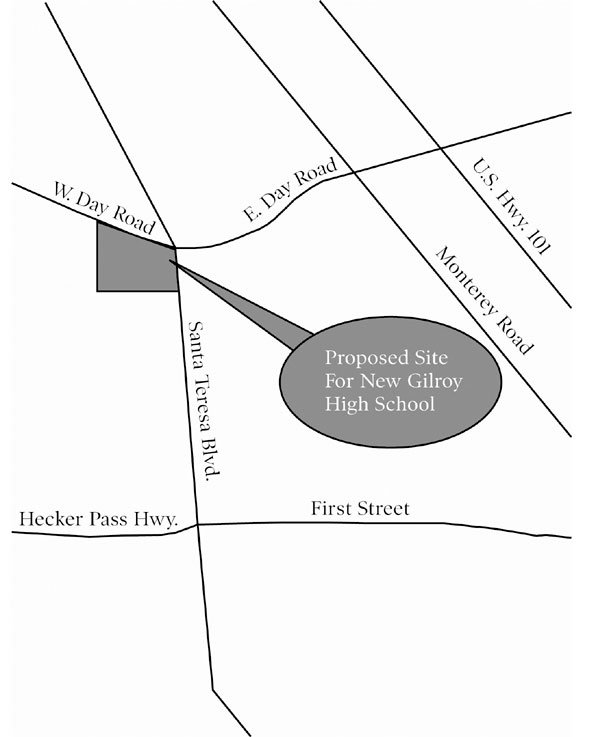Gilroy
– Gilroy’s second high school is by far the largest undertaking
among the several projects budgeted in the school district’s
long-range plan.
Gilroy – Gilroy’s second high school is by far the largest undertaking among the several projects budgeted in the school district’s long-range plan.
The proposed $38.5 million Christopher High School is slated to be built on 50-acres on the west side of Santa Teresa Boulevard at Day Road. When the district initially investigated possible sites for the second high school, a group of residents – many who lived off of Day Road – expressed their disdain for a high school in that area.
But out of the four or five sites the district considered – including one across from Antonio Del Buono Elementary on Wren Avenue and a couple more in southern Gilroy – school board members voted unanimously for the selected location.
At this point, no other locations are being considered, Superintendent Edwin Diaz said.
“There hasn’t been an indication or discussion from any board members that it’s not our first choice for a site,” he said.
The district last week received the site’s environmental impact report, currently under public review.
“We’ll go through that, and then determine if that’s still the best location,” Diaz said.
Gilroy’s second high school, scheduled to open in 2008, is named for garlic rancher Don Christopher and his family, who donated nearly 10 acres of land to the district for another school.
GUSD’s Director of Facilities and Construction Charlie Van Meter and Assistant Superintendent of Administrative Services Steve Brinkman presented school board members Tuesday with an update on the facilities master plan, a blueprint of the district’s goals for facility construction and improvements – including the upcoming high school – over the next 22 years.
Facility construction and upgrades are paid for by two bonds, Measure J and Measure I.
For the new high school, the plan earmarks $11.85 million for site development including utility and road extensions. The first phase of construction – which will build joint-use buildings and grounds for 1,800 students, a library and media center, main gym, cafeteria and food service area – will cost roughly $10.5 million.
Constructing classrooms for students at the new school is estimated to cost about $6.15 million. Land purchase, design, engineering and other costs such as inflation account for a little more than $10 million.
At the city’s current high school, where about 2,500 students attend classes daily, yellow hard hats and construction tape have become a common site. About $23 million already has been spent on improving the campus, with a little less than half allocated to a new student center that should be finished in about a year.
Other GHS improvements include expansion of the library and multimedia learning center, parking lot and campus safety improvements, new fire and security alarms and communication technology upgrades.
In reviewing the facilities budget, district staff managed to shave off just under $10 million of the original master plan budget, from $182 million to $172 million. Board members will vote on district staff’s proposed changes to the facilities master plan Dec. 16.
At Brownell Academy, a proposed $3.7 million multi-purpose room will provide space for a variety of uses, including food service and student activities such as school dances.
Recent construction at El Roble Elementary has built a multi-purpose room with food services and new restrooms for roughly $4.7 million so far. Other improvements to that school include a new library and multimedia center for $900,000.
At Mount Madonna High School, the district wants to add two modular classrooms for a total cost of $400,000.
Costing $4.3 million district-wide are improvements to structural facilities – also known as deferred maintenance – such as roofing, exterior paint, public address systems, carpeting, doors and windows, floor coverings, bathrooms and electrical systems. Since 2002, the district has spent $1.7 million for such improvements.
The budget for deferred maintenance items is based on one-half of 1 percent of the district’s general fund, which is about $60 million. The state is supposed to match that amount annually, but Van Meter said the state is notorious for slashing deferred maintenance provisions because of the dire state budget.
The most pressing deferred maintenance project in GUSD, costing between $300,000 and $350,000, is to improve Rod Kelley Elementary’s roof, Van Meter said.
Also included in the facilities master plan are a handful of projects that currently are not included in the facilities master plan but the district has identified as necessary.
Among those is some major work on GHS’s stadium track and turf, a $1.5 million plan. Jeff Gopp, the district’s manager of maintenance and operations, and Jack Daley, the high school’s athletics and activities director, told board members the overhaul is badly needed.
“As parts of the track come up, it’s becoming more and more unsafe,” Daley said. “It’s not just an athletic issue. That stadium is a P.E. classroom and supports the P.E. curriculum.”
Aside from the high school’s use of the field for soccer, football and P.E. classes, Gavilan College also pays about $7,000 per year in a contract with GUSD to play its games there.
Additionally, plans for Christopher High School do not call for a stadium, so that school would use the new track and turf as well.
The new, synthetic turf would reduce maintenance costs and prevent the chance of injury, Gopp said. If board members approve funding the stadium improvements, work could begin as soon as this spring.
Other improvements not budgeted in the master plan are technology upgrades to South Valley Middle School, Brownell Academy, Glen View Elementary and Rucker Elementary schools, including replacing the schools’ current public address and security camera systems.















